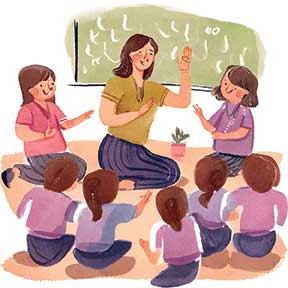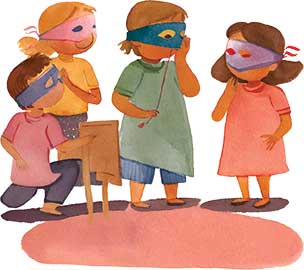Swati Chaliha

Bonoshree’s four-year-old child, Shouvik came home with a bright face from kindergarten. He was eager to share a novel experience with her. The kindergarten had taught him and his classmates how to communicate in sign language. He had learnt to communicate his name, feelings such as happiness, sadness, and anger, and messages like ‘I love you’, ‘you are great’ in sign language. With a sparkle in his eyes, Shouvik used sign language to show his mother – “My name is Shouvik and I am feeling happy.” He excitedly used the sign language stickers, which he had received earlier in the day, to help his mother learn and further went on to share that sign language is important to communicate with the deaf. Bonoshree was left pleasantly amazed. She got curious and spent the evening with Shouvik trying to communicate in sign language.
Intrigued, Bonoshree checked the term activity sheet that is sent out to parents at the onset of each term (one term in Shouvik’s kindergarten comprised three months). Peace and justice was the term’s theme. She further learnt that the school had invited representatives from the deaf and dumb association in the city, to communicate with the kids and make them aware of the need for and importance of sign languages.
Another activity on similar lines that the kindergarten arranged for these four-year-olds was to blindfold them and make them use their other senses to recognize different objects. The underlying message was to help them build empathy and awareness about blindness. The kindergarten invited representatives from an organization that works towards enabling the visually disabled to educate the children on the concept of Braille. The children had the opportunity to observe and read books written in Braille and feel the tactile dots. They also engaged in a Braille sketching activity and created their names in Braille using playdough.
During the storytelling sessions, the educators used books such as The Mermaid with no tail by Jessica Long and Listen: How Evelyn Glennie, a Deaf Girl, Changed Percussion by Shanon Stocker. The first picture book celebrates the life of Paralympic champion swimmer, Jessica Long who despite having amputated legs below the knee is one of the most decorated athletes. Shanon Stocker’s inspiring book narrates the true story of famous deaf percussionist Dame Evelyn Glennie. Evelyn played a couple of instruments from a tender age of eight. The loss of hearing didn’t inhibit her ability to perform. Although she couldn’t hear with her ear drums, she felt music in different parts of her body. These books were a message for the children on usage of our body parts in alternate ways.
Imparting lessons on inclusion at an early age fosters empathy and acceptance of individual differences for growing children. Having the opportunity to get exposed to the concept of differences could encourage these children to embrace differences. Bonoshree felt extremely satisfied and content to have been able to provide her child an environment that nurtures this pertinent need to foster inclusivity.

All this had her reflect on her knowledge and experience of inclusion as a child. She recalled that apart from watching news on Doordarshan with sign language interpretation and learning that it is for people with hearing disability, she had no exposure to these concepts during her school going years. She grew up in an environment which provided her limited understanding of physical and mental disabilities. Most of us probably give long stares when we encounter people with disabilities in public spaces. Although there is no intended harm, these stares surely do not make anyone with disability comfortable. A community to be kind towards people who express differently, needs to be aware of the differences and ways to make them feel at home in the community.
Inclusion in schools serves everyone – students with disabilities, students who are typically developing, and educators. Educators need to be trained on strategies for accommodating students with disabilities and our education system needs to create an atmosphere where education is tailored to the students and their learning styles, enabling them to be free to learn whether they are typical or atypical.
This experience was an eye-opener for Bonoshree. She is not sure if the activities planned by the kindergarten will help Shouvik be inclusive when he grows up, but these surely are welcome initial steps. When kids grow up to recognize that everyone has something to offer in the community, they are likely to build a world that is more tolerant and also encourage inclusivity.
The author is a natural resource management professional with a focus on applied research in climate change adaptation and restoration governance. She is mother to a five-year-old and loves reading with her child at leisure. She can be reached at swatichaliha@gmail.com.
